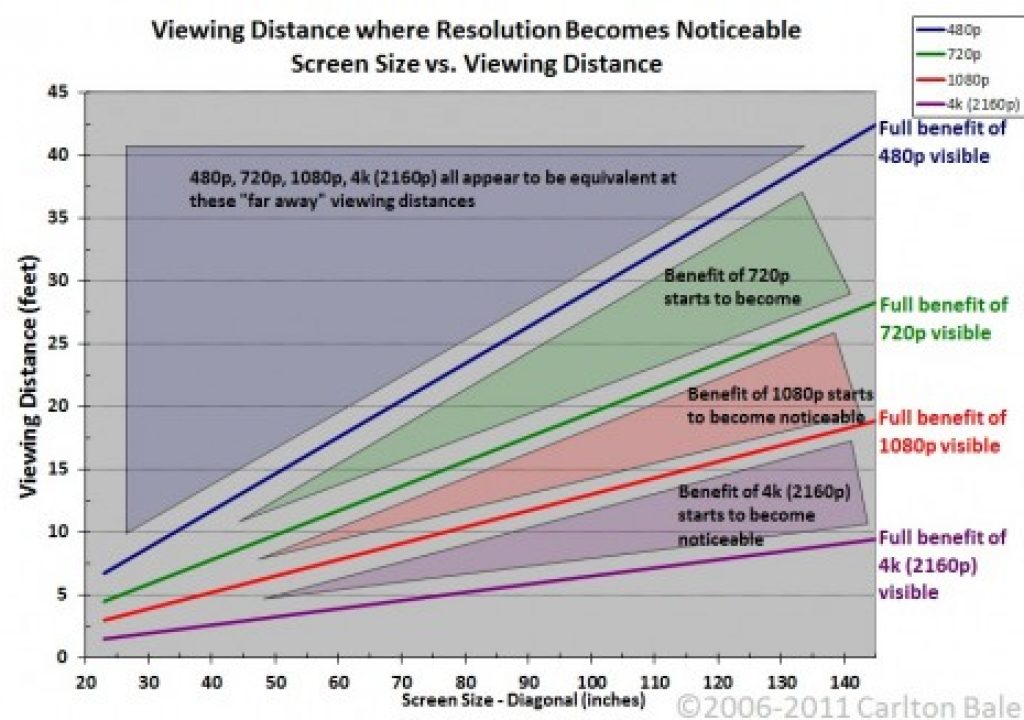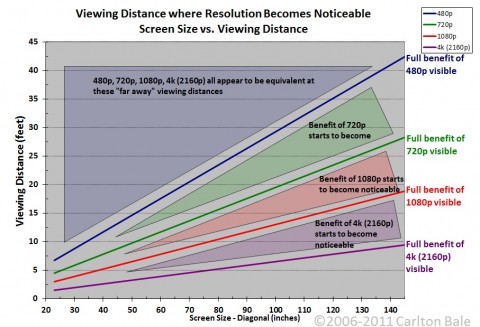There’s a nice, ranty article over at CNET entitled “Why 4K TVs are stupid” that talks about 4K TV’s in the home, and the coming marketing push from TV manufacturers. In the article, they summarize the mathematical reasons why our limited human eyes can’t resolve the 4096×2160 resolution offered by 4K TVs, in average home viewing conditions. It got me looking for more info on this topic…
Some time ago, Carlton Bale wrote an article called “Does 1080p Matter?” and included a very handy viewing distance chart. It clearly shows at what distances your eyes can resolve specific resolutions, and in fact, 1080P does matter to the average videophile…or in his words, “for a 50-inch screen….the benefits of 1080p vs. 720p start to become apparent when closer than 9.8 feet and become full apparent at 6.5 feet.”
We have an average-sized livingroom in our home, and I sit roughly 10 feet from our 50″ plasma TV. It’s a comfortable viewing distance, and the image appears crisp and clear. I could probably just as easily watch from 8 feet, if the configuration of the room allowed it. But I would probably not be comfortable viewing from closer than 8 feet. So according to the distance chart, in my home we’re right on the edge of discerning any real benefit from good ‘ole 1080p resolution.
In Bale’s latest article “Does 4K Matter?” he runs the numbers on what it takes to resolve the detail of 4K with your eyes. He reports that on a 84-inch screen, “4k resolution isn’t fully apparent until you are at least 5.5 feet or closer to the screen.” An 84 inch screen! So what about the rest of us in the 50-60 inch “affordable TV” category? Well, for a 55-inch screen, you’d have to be sitting no more than 3.5 feet away to fully discern the detail that 4K offers, and about 5 feet away to see any noticeable difference over 1080p. My nine-year-old son sits that close occasionally, much to my chagrin, but there’s no way I could watch a movie that close to the screen!
So whither 4K? Why would you film content at 4K resolution or higher? What benefits does it offer? Well it doesn’t, yet, in the average home. However, I do think that 4K and higher resolution makes sense for theatrical projection (though there are good arguments that 2K is currently the best bang for buck). And of course there is a compelling argument to originate source material at high resolution for compositing and visual effects applications. For filmmakers and content creators, these are plenty of others are compelling reasons why you would consider filming your project at higher than 1080 resolutions. That said, should you always originate at 4K+? Nope. But there are many good reasons to, if you can afford it and you understand the workflow.
But until you install a 100-inch TV in your living room, it appears that 4K TV in the average home won’t be a resolution upgrade. There may be other, less sexy benefits to the new 4K TVs, like contrast ratio and color accuracy, but 4K resolution effectively offers you no advantage in the average home.


